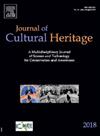Promoting conservation sustainability: Analysing biomaterials in 6–8th century Aurangabad cave mud plasters
IF 3.3
2区 综合性期刊
0 ARCHAEOLOGY
引用次数: 0
Abstract
This pioneering study offers a fresh perspective on ancient Indian mural artistry by analyzing the biomaterial composition of 6th-8th century mud plasters from the Aurangabad Caves. Using advanced techniques—Stereo Microscopy, Polarized Light Microscopy, FTIR, and GC/MS—the research identifies previously undocumented organic additives, including Echinochloa and millet grains, Fumaria seeds, proteins, waxes, and natural resins. The absence of rice husk and strategic use of straw and Echinochloa grains reveal a unique adaptation to the semi-arid climate, enhancing plaster durability, water repellence, and crack resistance. This first-of-its-kind analysis uncovers the sophisticated material selection by ancient artisans, offering insights for eco-friendly restoration of historic mud plasters. The study bridges historical craftsmanship with modern sustainable practices, contributing to low-carbon building methods and environmental sustainability.

促进保护的可持续性:分析6 - 8世纪奥兰加巴德洞穴泥膏药的生物材料
这项开创性的研究通过分析奥兰加巴德洞穴中6 -8世纪泥膏药的生物材料组成,为古印度壁画艺术提供了一个新的视角。使用先进的技术-立体显微镜,偏振光显微镜,FTIR和GC/ ms -研究鉴定了以前未记录的有机添加剂,包括棘皮藻和谷子颗粒,富马属种子,蛋白质,蜡和天然树脂。稻壳的缺失和稻草和棘球藻颗粒的战略性使用揭示了对半干旱气候的独特适应,增强了石膏的耐久性,防水性和抗裂性。这种首次的分析揭示了古代工匠的复杂材料选择,为历史泥膏泥的生态修复提供了见解。该研究将历史工艺与现代可持续实践相结合,为低碳建筑方法和环境可持续性做出贡献。
本文章由计算机程序翻译,如有差异,请以英文原文为准。
求助全文
约1分钟内获得全文
求助全文
来源期刊

Journal of Cultural Heritage
综合性期刊-材料科学:综合
CiteScore
6.80
自引率
9.70%
发文量
166
审稿时长
52 days
期刊介绍:
The Journal of Cultural Heritage publishes original papers which comprise previously unpublished data and present innovative methods concerning all aspects of science and technology of cultural heritage as well as interpretation and theoretical issues related to preservation.
 求助内容:
求助内容: 应助结果提醒方式:
应助结果提醒方式:


